History
Culture
Design &
Technique
How
To
Artists
Convocation
Glossary

Home
|
Aesthetics & Weaving
Techniques
The archaeological record provides ample evidence that these
very early textiles were not merely utilitarian. Textiles were
aesthetic items as well as practical ones. Even a casual study
of the subject reveals a magnificent variety of design and patterning.
|
Before
Cotton
Aesthetics & Techniques
Types
of Looms
|
| |
An elegant, lacy shirt found at Tonto Monument,
near modern day Phoenix, dates to about 1200 to 1400 A.D.
|
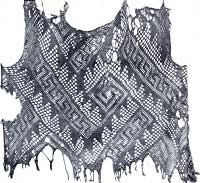
Enlarge |
|
|
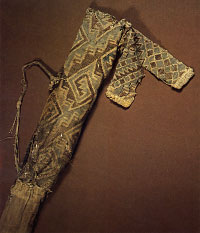
Enlarge |
A burial dating between 1100 A.D. and 1300 A.D. at Hidden House
near Flagstaff contained a quiver tapestry—woven in three colors.
|
|
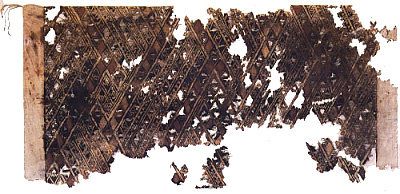
Enlarge
|
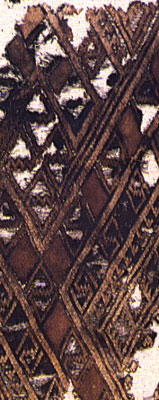
|
|
A blanket fragment elaborately worked
in a diamond twill tapestry in red, brown and white cotton,
dated 1132-1135 A.D., was found near Grand Gulch in Southeastern
Utah (detail right).
Early Weaving Techniques
|
|
These three examples exhibit a wide range of techniques.
The shirt is an example of a non-loom technique, sprang, a
finger-manipulated braiding technique. The quiver appears to
have been woven on a stick loom, also known as a backstrap
loom. The top, bottom, and side selvedge fragments of the blanket
indicate that it was made very much in the same manner as historic
textiles of the Pueblo people, that is, on an upright frame
loom.
This type of loom produced rectangular pieces
of cloth. Pre-contact breech cloths, mantas, shoulder blankets, kilts,
sashes, shirts, and belts are all variations on this shape. Pueblo people used
the
cloth in the same shape as it was woven, without cutting and tailoring. Occasionally
they would cut down a larger piece, such as a manta, to make a smaller
item such
as a kilt, hemming the raw edges. The rectangle continues to be the basic
shape of contemporary ceremonial clothing, even though artists today use machine-woven
cloth (see Yarns& Fabrics).
|
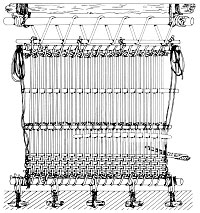
More about looms
|
The blanket fragment
is about the same length as the white
cotton mantas made
today. The
designs on
the quiver
and the blanket were made using different colored yarns,
much as contemporary designs are. All of these pieces were
made
of handspun cotton, all are elaborately decorated; but none
of them are embroidered.
When did Southwestern peoples begin embroidering their textiles?
|
|
|
|
|
|
|
|
|






